Emma Jameson – 17 September, 2014
Clemens' video raises more unanswerable questions the more times it is viewed and considered. Is it easy to watch? Most definitely not. But the way in which Clemens seems to create an integrated narrative out of a series of sharply cut film scenes is extremely clever in its execution and in the concepts that it seems to suggest…. Clemens' work is as much about Westhaven Marina as it is about the role of video media to reflect, distort and disrupt reality.
Eddie Clemens’ Wes Craven Marina is a complex mélange of visual references that demand to be ‘unboxed’ in the mind of the viewer. Film stills merge with video clips taken from the internet and footage filmed by the artist, creating a multitude of meanings that disturb the trajectory between reality and fantasy, horror and comedy.
As with his latest project entitled Collector’s Edition Glitch (Viewing Bridge) the Adam Art Gallery, in which he reimagines the gallery space as settings from a medley of James Cameron films, in this work Clemens explores the relationship between Hollywood illusion and real life actuality. In Wes Craven Marina he transforms the recently developed Westhaven Marina into a Wes Craven film set in which the normal or everyday is sensationalised or becomes evocative of something darker and more sinister. In the first shot the harbour bridge appears, obscured by a thick mist. Such evocation of a sinister, ominous mood is made explicit through the inclusion of film stills from A Nightmare on Elm Street: Nancy and Glen talk about nightmares coming to life, Freddy Krueger seems to be walking out towards us from the Girl Guides’ boating club, and finally the nightmare of Freddy Krueger comes to life before our eyes in the form of the artist. He assembles his costume as Nancy and Glen talk and then roams around the Westhaven marina, producing a connotative referent that shapes our understanding of the environment.
Westhaven Marina becomes a nightmare landscape in which nothing is beyond the realms of possibility. Inspired by the surreal nature of David Lynch films, in which neither the audience nor the characters can distinguish between what is real or imagined, Clemens bombards the viewer with a series of clips that do not have an immediate connection to each other. After seeing the Freddy Krueger clip on the façade of the boating club we suddenly see a short video clip discussing the invention of the clothes hanger. This cuts to clips of our Freddy Krueger impersonator kayaking through the harbour and bungee jumping off the harbour bridge.
A clear narrative is denied of the viewer and we are left feeling unsettled and uncertain. What is real? What is fantasy? What is relevant? Like the scene in Mulholland Drive in which a man’s description of a nightmare slowly turns into reality, we too start to view things with suspicion. A bulldozer raking through the water is made to seem strange and unknowable through the manipulation of soundtrack and film speed. The everyday environment is made sinister and uncertain, refuting any sense of clear knowability.
As with Collector’s Edition Glitch (Viewing Bridge), Clemens effectively utilises the gallery space to further confound the distinction between cinematic illusion and lived reality. The screen projecting the video is mounted on an impressive steel sculptural replica of the fishing limits signs that can be seen at marinas all over the country. An object from real life has been appropriated and modified, blurring the distinction between life and art and prompting evaluation as to how these two are intertwined. The nightmarish vision of a strange and uncertain Westhaven Marina presented through the art of the video is perhaps the expression of the social effects of Auckland’s gentrification, in which known and familiar environments are transformed into detached, depersonalised and fabricated social stages. Commerce and surface appearance are favoured over community and social integration. The uncertainty sensed when regarding the bulldozer in the video is perhaps emblematic of the apprehension felt when new building projects are announced in the media. Does the sign’s warning against ‘over fishing’ then extend to a warning of over developing?
Yet Clemens’ video is not merely social critique. It is unabashedly self-reflexive in its status as ‘video art’ through its mixing of various internet and cinematic references. We are constantly reminded of the work’s status as a work of mediated, subjective fiction. The curvilinear lines of the fish shapes anchoring the screen not only create an undulating rhythm, but also serve to underscore the constructed context of the gallery space in that we can see the white walls of the gallery in the gaps between the steel bars.
Similarly, the clip from A Nightmare on Elm Street is denied any sense of realism through the distorted voices of the characters and the superimposition of a clip of the artist preparing his Krueger costume. This is not a real horror film, but is the creative productive of an individual. Similarly, this is not the real Krueger, but rather a game of dress-up and make-believe. What should be scary is rendered comic in its celebration of its status as fictional fantasy. We see ‘Krueger’ ruining his costume by spray-painting leaves by accident and then his cardboard claws getting bent backwards as he speeds across the harbour bridge. His exploration of the Westhaven Marina is not an ominous journey seeking violent satisfaction, but is rather a spontaneous, thrill-seeking leisure activity that is akin to the bungee jump that he does from the harbour bridge.
The insertion of YouTube clips of ‘unboxing’ and conspiracy theories about the Monster energy drink (supposedly its branding is a blatant support of Satanism) perhaps indicate that Wes Craven Marina is another wild goose chase of a conspiracy theory. At the very end of the video, the brand of Monster drinks becomes fused with the pavement on the marina, suggesting yet another meaning within this multi-layered video. Is Clemens’ Krueger exploration of Wes Haven Marina aligning gentrification with surreal instability? Or is it subtly mocking those who rile up against government policies by claiming illicit corruption and conspiracy? Is this social documentary or another piece of subjective fiction that masquerades as documentary on YouTube?
Clemens’ video raises more unanswerable questions the more times it is viewed and considered. Is it easy to watch? Most definitely not. But the way in which Clemens seems to create an integrated narrative (albeit one that is for interpretation and not instruction) out of a series of sharply cut film scenes is extremely clever in its execution and in the concepts that it seems to suggest. In including film clips of cinematic legend and social media trends, Clemens’ work is as much about Westhaven Marina as it is about the role of video media to reflect, distort and disrupt reality and our compliance as viewers with this. Unsettlingly surreal and self-referential, it is demonstrative of the powerful potential of video media to both interact with an environment yet retain its integrity as an autonomous art product.
Emma Jameson is the 2014 EyeContact Artists Alliance Writing Intern, a programme made possible with generous funding from the ASB Community Trust.
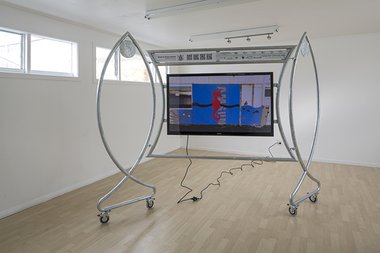
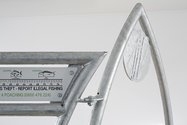

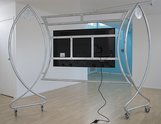
 Advertising in this column
Advertising in this column Two Rooms presents a program of residencies and projects
Two Rooms presents a program of residencies and projects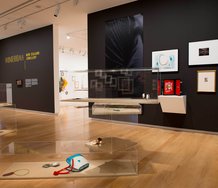
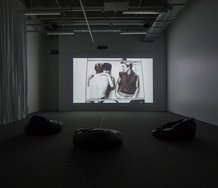


This Discussion has 0 comments.
Comment
Participate
Register to Participate.
Sign in
Sign in to an existing account.